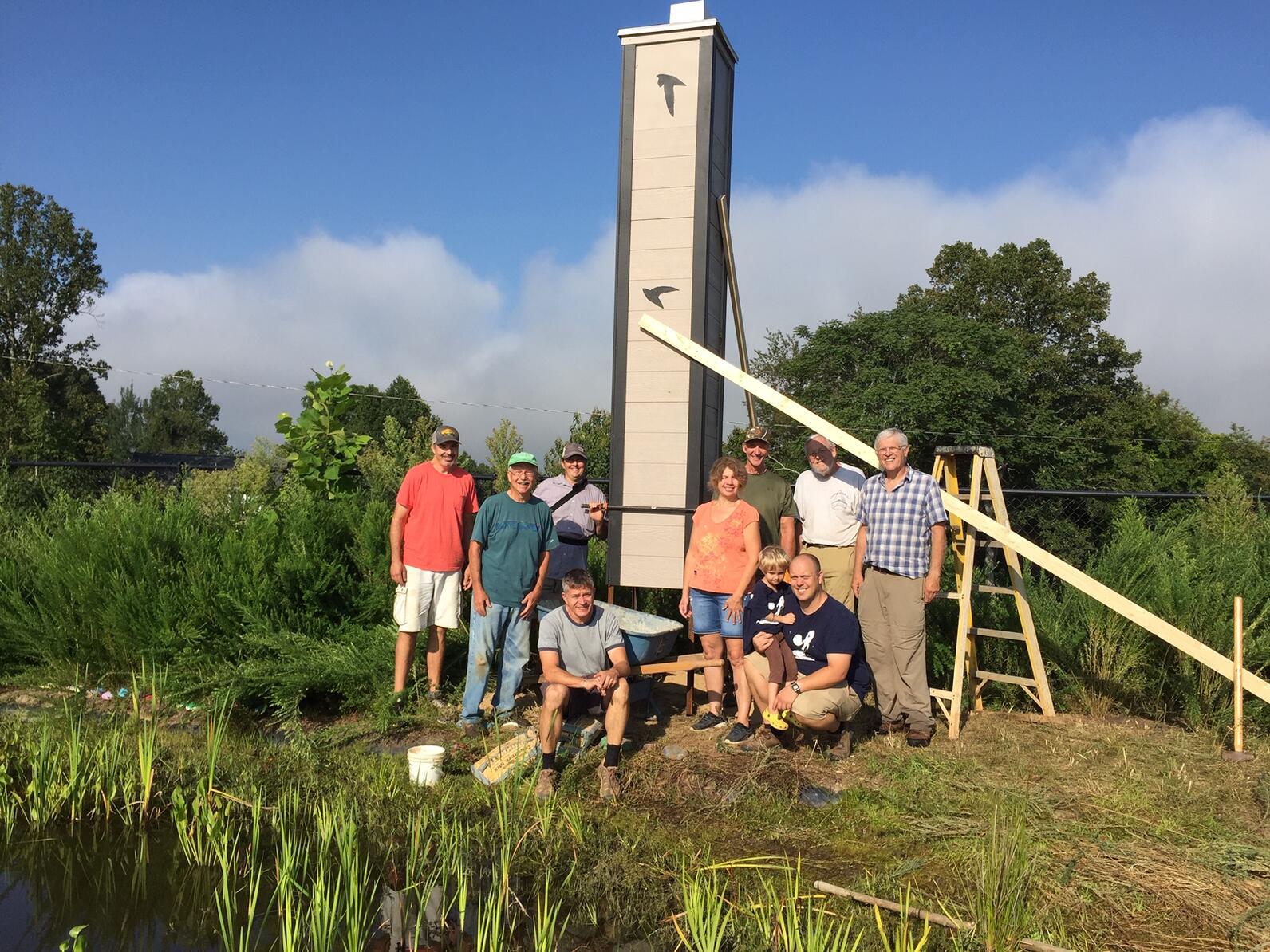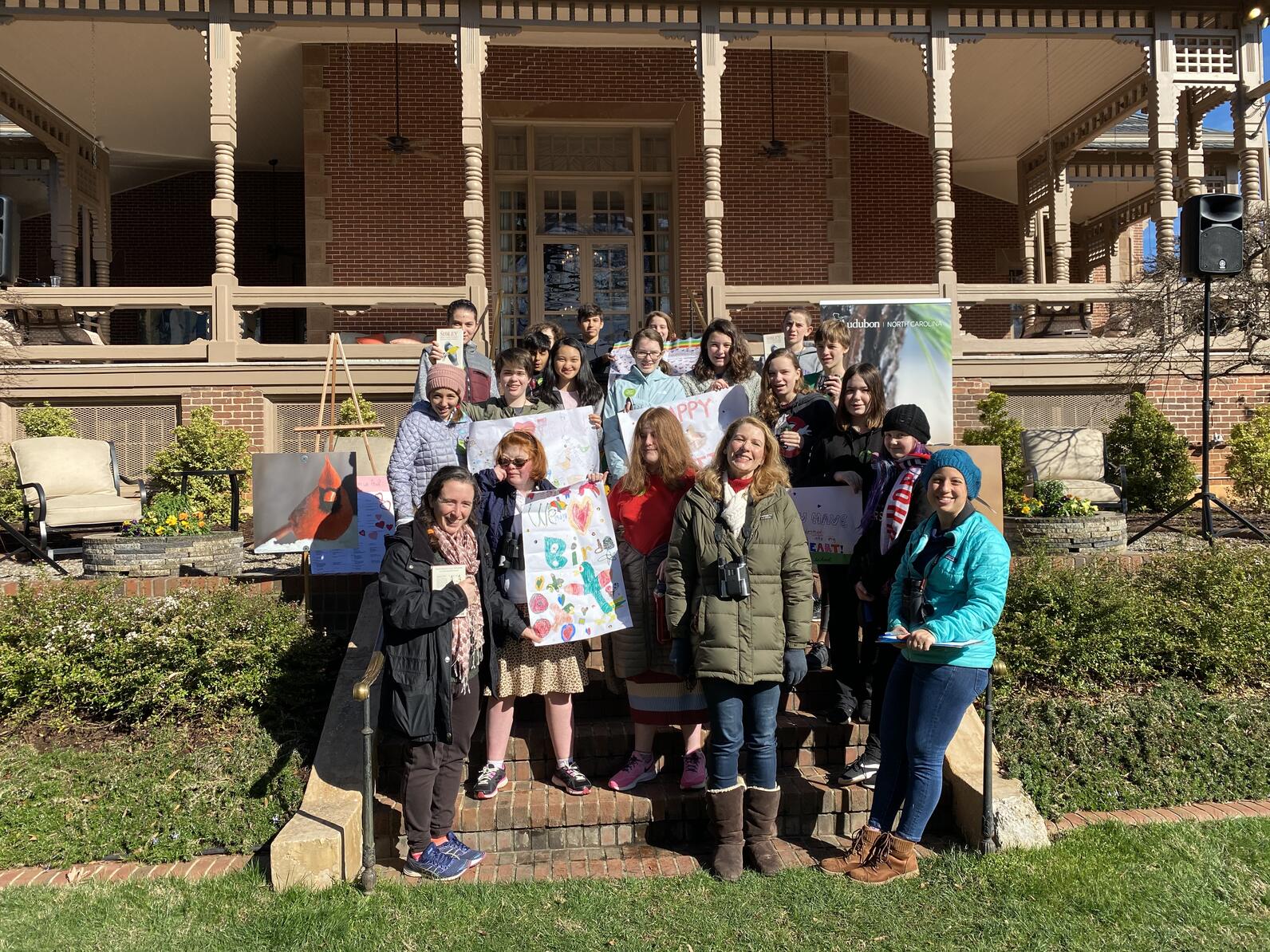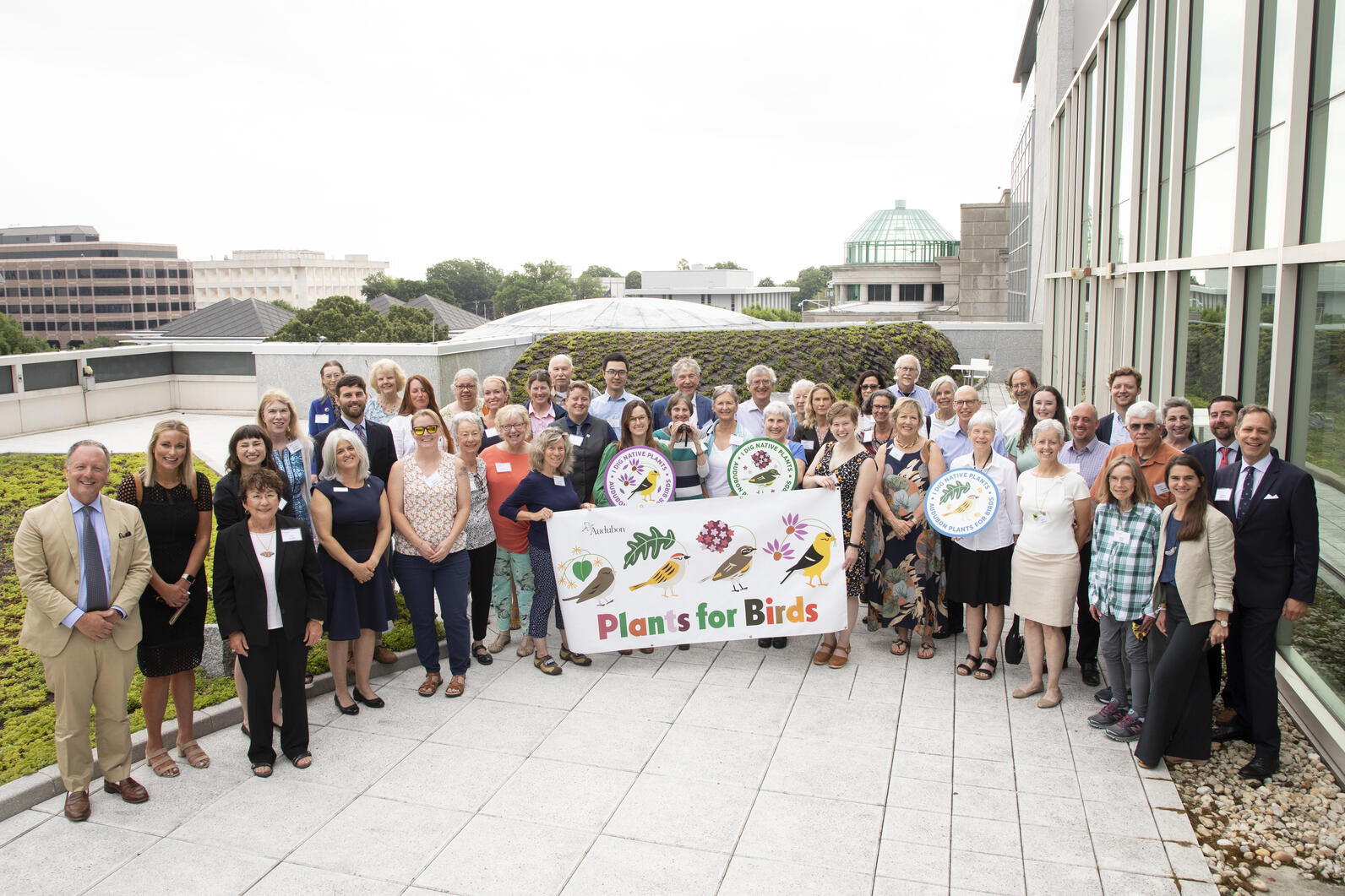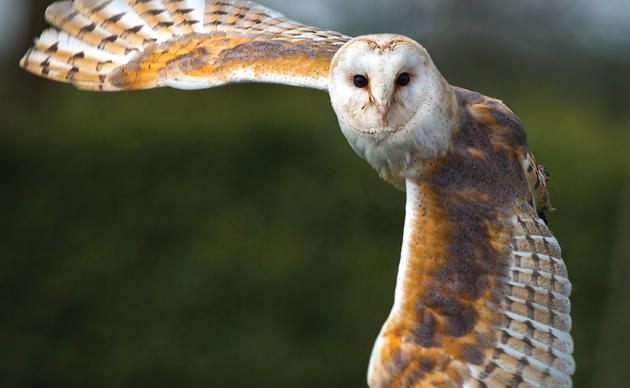Birds inhabit every part of North Carolina’s landscape, from the isolated marshes of Currituck Sound to the highest peaks of the Blue Ridge Mountains, but also all of the backyards, community parks, and downtown skylines in between. That is why Audubon launched the Bird-friendly Communities program a decade ago, to ensure that birds can thrive where most people live—in cities and towns.
Looking back after ten years, we’re proud to say that birds are better off thanks to the work of Audubon and our chapters. There are more native plants blooming in North Carolina. The night skies above towns and cities are darker and safer during migration. Nuthatches have thousands of safe places to raise their chicks thanks to nest boxes installed by our members. And Chimney Swifts have more places to nest and roost.
Just as importantly, people across the state are more aware of their backyard birds and the conservation issues they face. These folks are now plugged into their local chapters and feel empowered to take action to help birds.
“I’m especially proud of how our chapters have taken these tools, adapted the program to best fit their strengths, and led the way,” said Interim Executive Director Curtis Smalling. “They have modeled a new way to do conservation across the Audubon network.”
Here are some of the numbers:
-
14,000 nest boxes installed for Brown-headed Nuthatches
-
8 cities with Lights Out programs with local government and/or building owners
-
More than a dozen native plants policies, proclamations, and ordinances championed by chapters and passed by local and state governments, including a landmark bill this year that requires native plants at all state parks, roads, and historic sites
-
40 Chimney Swift towers installed
While the Bird-friendly Community program benefits all birds in our state, Audubon has worked to target specific species that are important to North Carolina and could see a positive impact on their populations through the actions of citizens. As a result, we’ve seen improvements to both species and community health over the last decade. These species include the Brown-headed Nuthatch, Prothonotary Warbler, Chimney Swift, and Wood Thrush.
We wanted the focal species to be widely distributed across the state, have some level of conservation concern, represent a variety of ecosystems and habitat types, and all be associated with an action that moved Bird Friendly Communities work forward. Read on for a full recap.
Thousands of Nest Boxes for a Vulnerable Southern Species
The Brown-headed Nuthatch is a tiny brown bird with a squeaky song that sounds like a dog chew toy, and is only found in southeastern pine forests. Because of their specific habitat preferences, unique location in the southeast, and the direct impact communities could have on their conservation status, they were chosen as one of the focal species in North Carolina.
The Brown-headed Nuthatch range is extremely threatened by climate change. Under a 2-degree warming scenario, nuthatches will lose most of their southeastern range, a large portion of that in North Carolina. Along with this range shift, nuthatches are losing the pinewoods and dead trees they need for food and nest cavities due to urbanization and deforestation. One solution to ensuring that they can continue to thrive in North Carolina is to increase the places where they can breed and nest.
We launched a program to help this species by working with chapters to distribute nest boxes in communities throughout the state. From the start of the program, our goal was to put up 10,000 Brown-headed Nuthatch boxes and we were able to accomplish that fairly quickly. Since 2013, we estimated that 14,000 Brown-headed Nuthatch boxes have been placed statewide, all of which have had a big impact.
A recent survey sent out to participating chapters, cities, parks, universities, and community members showed that 55 percent of boxes were used by nuthatches at least once. That’s nearly 8,000 breeding pairs of birds! Over 75 percent of the boxes also hosted chickadees or House Wrens at some point since installation.
The species remains vulnerable, but some data, like the North American Breeding Bird Survey, show improvement over the last decade. Every nest box helps!
Chapters Make the Night Skies Safer for Birds
Across the state, chapters have launched Lights Out programs to make the night skies darker and safer for migrating birds. Their efforts have made North Carolina a leader in the Lights Out movement over the last decade.
Chapters have educated their communities about ways to reduce light pollution and make homes and buildings safer for birds. They have also pounded the pavement, recruiting volunteers to walk through downtown areas during migration and search sidewalks and hedges to count the number of birds killed by building collisions. Using this data, chapters have advocated for city-sponsored Lights Out programs and other measures that can have a community-wide impact. They continue to meet with building owners, city councils, planners, and officials to install motion sensors on lights, install window treatments, and overall reduce the hazards that make it harder for migrating birds to navigate the night sky.
Since the start of our Lights Out program, six cities—including Ashville, Chapel Hill, Greensboro, Matthews, Cary, and Raleigh—have adopted Lights Out programs. In Charlotte and Winston-Salem, chapters have identified buildings that are the biggest threat to birds and partnered with individual building owners to turn off unnecessary lights. This year, Wake Audubon, which celebrated the 10-year anniversary of Lights Out Wake in Raleigh, partnered with Kane Realty, one of the biggest real estate companies in Raleigh to go Lights Out.
Lights Out work requires constant engagement as building owners change and elected officials come and go. That’s why our chapters are so successful, because they are able to maintain partnerships at the local level to ensure that programs are implemented in a sustainable way.
The success of chapters like Forsyth Audubon, Blue Ridge Audubon, and Cape Fear Audubon has formed a strong base for our campus chapters to get involved. UNC Charlotte, UNC Wilmington, and UNC Asheville have all learned from their local chapters and have started their own on-campus Lights Out initiatives. From advocating for bird friendly window treatments and installing automatic motion sensors on lights to collecting bird-building collision data, our campus chapters are carrying Lights Out momentum forward.

Chimney Swifts get new Towers
The Chimney Swift is an extremely specialized bird. Once nesting and roosting in hollow trees and caves, they have since adapted to the built environment, using chimneys instead. Even with this change, their population has declined by two-thirds over the last half century due to habitat destruction and other factors like declines in aerial insects.
Because of their reliance on chimneys, people can have a direct impact on their conservation and success across our state. Over the past ten years, the state office has provided support for chapters to survey and track swift population trends, find resources to build new swift roosts, and work with building owners to uncap chimneys or save chimneys from demolition.
Over the course of the program, 40 swift towers have been built, from Mattews to Black Mountain. Chapters have forged unique partnerships, installing towers at parks, natural areas, and elementary schools. They have also worked with building owners to keep chimneys uncapped for swifts, such as the chimney at Transfer Co. Food Hall in downtown Raleigh.
Each fall, chapter members go out in their community and count the number of swifts at different roost sites so that we can learn about local population trends. Chapters also hold “Swift Night Out” events at various roosting locations so that people can witness the magic of swift migration and learn more about this important bird.

State-wide Success with Native Plants
Simply put, there are more native plants growing across North Carolina today thanks to the work of Audubon and our chapters. More beautyberry is fruiting in backyard gardens; more flowering dogwoods are blooming in front of downtown buildings; more native flowers are being planted in parks, thanks to this work.
We put the issue on the map for city councils, urban planners, homeowners, landscape architects, nursery owners, local planners, and even the state legislature. We’ve connected individuals with the importance of native plants for birds and people while providing the technical support and resources to get more native plants in the ground.
When we first launched the program, we highlighted a native plant species each month. One of our first was spicebush (Lindera benzoin), a native shrub that provides nutritious fruit just in time for fall migration, supporting birds like the Wood Thrush as they fly south. The native plants program had grown so popular that within days, nurseries across the state were sold out of spicebush.

Building on this momentum, chapters have developed community programs, including Bird Friendly Yard Certifications and plant sales. Most recently, New Hope Audubon in Chapel Hill developed a manual on managing native plant landscapes which highlights the benefits, challenges, and requirements for sites located in the Piedmont.
We’ve worked with chapters to pass more than a dozen native plants policies at the local and state level. In many instances, chapters have lobbied their city and county governments to change ordinances, removing invasive species from city and county plant lists and requiring the use of native plants. This includes a landmark policy requiring the use of native plants at all state parks, historic sites, and roadways as well as a North Carolina Department of Culture and Natural Resources policy requiring the use of native plants on all their managed lands.
In order to help nursery owners, city planners, landscapers, landscape design professionals, and gardeners learn more about which plants help birds and pollinators, we developed a list of 700 bird friendly native plants. This resource was created to help localize native plants advocacy and make it easier for folks to identify what might work for their community.
Continuing the work
When our first meeting was held at Walnut Creek Wetland Park in southeast Raleigh, we brought together chapters, faith groups, agency partners like the Wildlife Resources Commission, Native Plant Society, landscape architects, and planners. At that first meeting we set out a bold vision of what we hoped the program would look like in ten years.
Our vision was that Bird-Friendly Communities across North Carolina would give birds the opportunity to succeed by providing connected habitats dominated by native plants, minimizing threats posed by the built environment, and engaging people in the stewardship of nature. “I think it’s safe to say we stayed true to that vision and have made a difference for birds and people across the state,” said Smalling.
We look forward to continuing this important work. Connect with your local chapter to learn more about how you can help.








